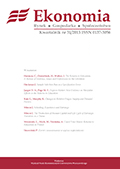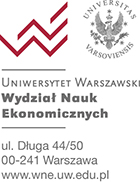Kluczowe czynniki wzrostu wartości ekonomicznej przedsiębiorstw branży odzieżowej
S. Juszczyk, M. Tymiński
ABSTRAKT: The aim of this paper is to identify the key factors which are affecting the economic
value of clothing companies. The study determines the relationship between
the applied strategy of financing assets and financial situation of enterprises.
Used in the participation rate of net working capital to total assets, also
includes ROA, ROE, liquidity and equity multiplier. Assessment was measured
using the Value at Risk. In the researched process the following key explanatory
variables were selected: sales, expenses, assets, working capital,
debt capital, equity, receivables, inventory, productivity. Not all of the explanatory
variables occur simultaneously in all the years of study. However, two
explanatory variables have been constant, namely: costs and foreign capital.
Pełny tekst (PDF)
Numer wydania: 32
W numerze:
Kluczowe czynniki wzrostu wartości ekonomicznej przedsiębiorstw branży odzieżowej
S. Juszczyk, M. Tymiński
ABSTRAKT |
PDF
The aim of this paper is to identify the key factors which are affecting the economic
value of clothing companies. The study determines the relationship between
the applied strategy of financing assets and financial situation of enterprises.
Used in the participation rate of net working capital to total assets, also
includes ROA, ROE, liquidity and equity multiplier. Assessment was measured
using the Value at Risk. In the researched process the following key explanatory
variables were selected: sales, expenses, assets, working capital,
debt capital, equity, receivables, inventory, productivity. Not all of the explanatory
variables occur simultaneously in all the years of study. However, two
explanatory variables have been constant, namely: costs and foreign capital.
Obciążenie gospodarki chorobami przewlekłymi - problem nie tylko ochrony zdrowia
I. Rudawska
ABSTRAKT |
PDF
Chronic diseases are currently the main cause of both disability and death worldwide. The heterogeneous group of diseases, including among others, cancers, cardiovascular illnesses, chronic respiratory conditions and diabetes, affect people of all ages and social classes. It is estimated that chronic conditions are responsible for 60% of deaths globally [Abegunde et al., 2007]. The burden is predicted to worsen in the years to come. A WHO study projected an increase of global deaths by a further 17% in the period 2005–2015 [WHO, 2005]. The heavy burden of chronic diseases and their multiple effects on productivity and demography plays an important role in the performance of the national economy. The correlation between health and economic growth is therefore one of the most crucial issues worldwide. The aim of this paper is to discuss the scale and trends in the burden of chronic diseases on the economy. The author takes into account direct, indirect and immeasurable costs of chronic illnesses.
Statistical Data and Models Used for Analysis and Management of Financial Stability at the Macro Level
M. Łupiński
ABSTRAKT |
PDF
In this paper we discuss statistical data requirements and modeling frameworks
used for macro prudential analysis and policy making. We start with
a short overview of causes, for which this kind of policy was introduced after
the last financial crisis and its links with traditional micro-level supervisory
and challenges generated for national and international statistical systems.
We point out a group of implications which financial stability, seen from
macro perspective, brings for data andmodels requirements, determined with
introduction of consecutive Basel Accords and made operational with
FINREP and COREP packages. Our special attention is paid to systemic risk
models, which provide very precious knowledge about institutions’ dependencies
and probabilities of shock spillovers within and across sectors. Expected
problems with statistical data requirements fulfillment and models structure
specification are also discussed and some possible solutions are hinted.
Odniesienia do modelu Mundella-Fleminga w nowych badaniach na tle ewolucji badań nad transmisją efektów polityki makroekonomicznej między krajami
A. Domańska
ABSTRAKT |
PDF
The aim of this article is to present selected modern modeling approaches
used in analyzing international transmission of economic impulses (shocks)
between countries and in particular the international effects of macroeconomic
policy referring to the Mundell-Fleming model’s general concepts. The
crucial aspect of the subject in question is an attempt to show, on the examples
given, how the original Mundell-Flemingmodel has been “evaluating”, i.e. has
been developed and modified by its followers in their endeavor to reflect the
complicated reality of modern international economic relations and the economies’
mutual influences in the best possible way. Those modifications and
improvements were expressed in abandoning some simplifications taken in
the original model, adding new assumptions (for example regarding the imperfectly
competitive markets, intertemporal choice, asymmetry of information,
imperfect capital mobility), combining the Keynesian short-term analysis with
some elements of the long-term approach, launching the dynamic concepts,
wide application of the advanced econometric methods (quantitative tools),
etc. The crucial aspect of the presented issue is that the basis created by the
Mundell-Fleming model can be found in the newest multi-aspectual models
used for a broad analysis of the current global economy and forecasting its future
trends like Multimod by IMF, INTERLINKOECDor the New Global Model
OECD.
Ewolucja kontroli wewnętrznej w kierunku efektywnościowym w instytucjach publicznych
L. Chodorowski
ABSTRAKT |
PDF
This article describes the growing importance of effectiveness in the internal
control system in public institutions. This new “effective” approach to internal
control has already been noted in literature. Moreover, the Regulation on public
finance dated 27 August 2009 introduced the notion of the effective “managerial
control” in the area of functioning of the Polish public administration and
local governments. The COSO I model also underlines the necessity of permanent
research of the operations productivity and the evaluation of effectiveness
of the internal control system as a whole in a given company, which is especially
important for the management. Additionally, the INTOSAI guidance
and the Standards of European Commission no 1341/2007 point to the effective
aspects of the internal control system.
The full and efficient internal control system in an institution should consist of
3 integrated lines: current control, control conducting after carrying out operations
and also internal audit. The internal audit has an important role in the
internal control system efficiency evaluating for the management. The organizational
structure of the institution has crucial influence on the internal control
system and its effectiveness. The hierarchic structure is a natural environment
favorable for the internal control system, however the process approach
usually stimulates and facilitates the research of effectiveness of control
mechanisms built into a given business process. The effective internal control
system can support the implementation of strategy in a given institution by
periodically checking the level of achievement of strategic sub-purposes.
Finally, it can observe the gradual evolution of internal control towards effectiveness
in central banks and other public institutions, which means a better
awareness of “control culture” among staff and a better quality of Corporate
Governance.
Foresight i Innowacje Jako Determinanty Kondycji Gospodarczej na Przykładzie Gospodarki Szwedzkiej
J. Prystrom
ABSTRAKT |
PDF
The processes of globalization, changing economic conditions and customer’s
expectations are forcing economies and functioning in these entities to be
ready for constant change and adaptation.
Innovative activity and foresight can help them with this challenge. Thanks to
innovative activity, innovative entrepreneurship is able to survive and overcome
the threat of increasing competition. A similar effect can be attributed to
the nature of the foresight essence. Overall, the key idea is to anticipate and
prepare for the events, phenomena, processes or whatever needs to take place
in the future.
The purpose of this article is to attempt to characterize the innovation and
foresight as determinants of economic viability, enabling adaptation to ongoing
changes and occurring phenomena on the example of the Swedish economy,
which is considered to be the one of the most innovative and competitive
in the world.
Funkcjonowanie Wielkiego Centrum Handlowego w Ujęciu Przestrzennym i Czasowym (na przykładzie Bonarka City Center w Krakowie)
T. Chaberko, M. Ciechowski, P. Kretowicz
ABSTRAKT |
PDF
This article considers shopping mall as:
a) a place of spatial influence as evidenced by the area customers commonly
come from (on a local, regional and country-wide scale),
b) a place of customers’ arrivals over time (during different times of the day
and week).
An example of the Bonarka City Center—a newly opened shopping center located
in Cracow—was employed to tackle four significant issues. The research
procedure included a field data gathering carried out in February 2010 in the
underground parking lot situated beneath the mall major trade area. Each investigator
was to note down the number of cars entering the lot, license plates
county code and the number of passengers inside. Besides, all of the people
were subjectively classified to different age groups. Customers who came on
foot or by public transport were not included in the analysis.
First, the authors endeavored to determine the size of daily traffic at the shopping
center. Secondly, the main directions of customers’ arrivals (crude, controlled
for population and per automobile) enabled to delineate the major
area people are attracted from by the shopping mall. Thirdly, an analysis over
time revealed peaks and trough times over the daily traffic, both diverse during
a working day (here: Tuesday) and weekend (here: Saturday). The final issue
discussed hereby concerned the customers’ age in relation to the arrival
times, which allowed tracing a varying demand over a day.

